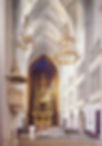The parish church of St. Augustine: Vienna's icon of beauty, culture and history
- Feb 16, 2024
- 2 min read
The Order of Saint Augustine is primarily distinguished by its spirituality and charism. However, it is also recognized in many regions for its beautiful architecture used to build its shrines and priories. Prominent within this collection is the Church of St Augustine (or the Augustinerkirche) in Vienna, Austria, whose beauty and structural majesty is complemented by a great historical and cultural richness. Read on to find out more.

History of the Augustinian Church
It was built in 1327, in Baroque style, by the Habsburg Duke Frederick I "the Fair", next to the Imperial Palace of Hofburg. There he established the hermits of St. Augustine in what would later become one of the leading monasteries in Central Europe. This was because the Augustinian community produced brilliant scholars, such as Leopold of Vienna, author of the influential late 14th century work the "Chronicle of the 95 Rulers."
Moreover, it became the monastery of the Habsburg court and the site par excellence for religious ceremonies. Among them are numerous weddings - including Maria Theresa to Franz Stephan von Lothringen in 1736; Emperor Franz Joseph I to Sisi in 1854; Crown Prince Rudolf in 1881 to Princess Stephanie; and even French Emperor Napoleon Bonaparte to Marie-Louise in 1810.
Given this courtly status, the Church of St Augustine also increasingly became an exclusive burial site for the nobility.
Distinctive features of the Augustinian Church of Vienna
Unique peculiarities and curious facts abound about this great building, such as:
The Knights of the Order of George, a Habsburg knightly order in the courtly fashion of the late Middle Ages, would meet in the aptly named St George's Side Chapel.
It was the starting point for pilgrimages, processions and funerals of the imperial household.
In the Loreto Chapel is the so-called "Vault of Hearts", where 54 Habsburg hearts are kept in silver urns.
It has an important collection of sacred art, with paintings and sculptures by renowned artists of the time, not least the tomb of the Archduchess Maria Cristina by Antonio Canova, a masterpiece of classical architecture, made of white Carrara marble between 1798 and 1805.
The church has two organs that have given it great musical prestige over the years - it is where Franz Schubert composed his Mass in F major and Anton Bruckner premiered his Mass in F minor.

The Augustinerkirche and the Order of St. Augustine
The Augustinian church in Vienna became a court parish in 1634 when the Augustinian friars took over the pastoral and spiritual care of the members of the imperial court. Despite this, the monastic reforms of Emperor Joseph II gradually reduced the number of friars until the monastery was finally dissolved in 1836. The parish continued to be run by secular priests until 1918, and the monastery was revived only in 1951.
Today, the parish of St Augustine is recognized as an important tourist, historical and cultural attraction in Vienna, with its Sunday morning High Mass, accompanied by choir and orchestra, as well as its sacred music concerts.
